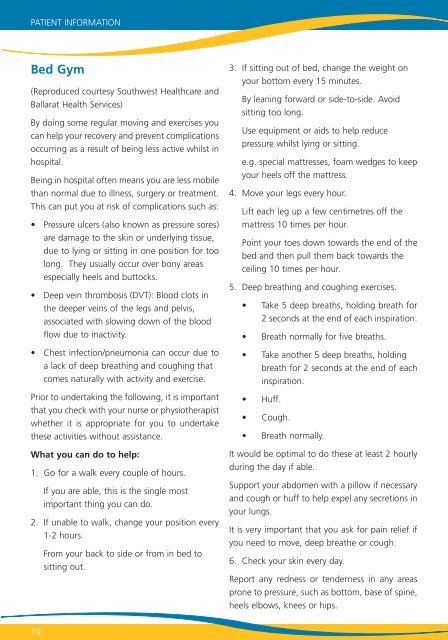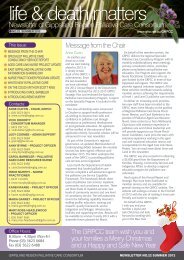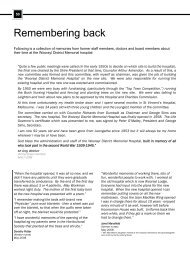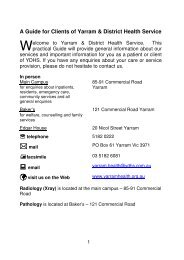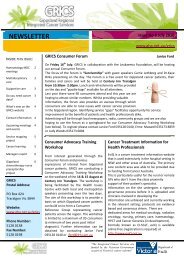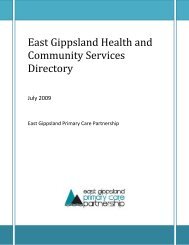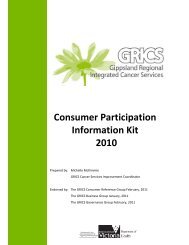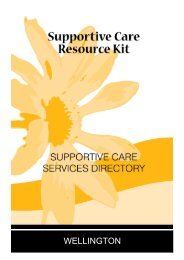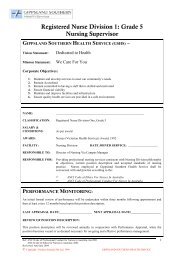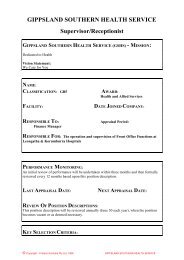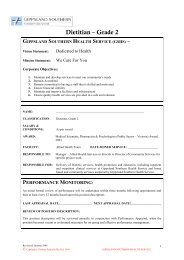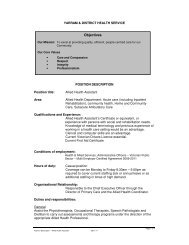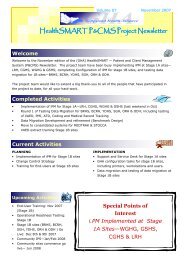HOSPITAL PATIENTS GUIDE
HOSPITAL PATIENTS GUIDE
HOSPITAL PATIENTS GUIDE
You also want an ePaper? Increase the reach of your titles
YUMPU automatically turns print PDFs into web optimized ePapers that Google loves.
PATIENT INFORMATION<br />
Bed Gym<br />
(Reproduced courtesy Southwest Healthcare and<br />
Ballarat Health Services)<br />
By doing some regular moving and exercises you<br />
can help your recovery and prevent complications<br />
occurring as a result of being less active whilst in<br />
hospital.<br />
Being in hospital often means you are less mobile<br />
than normal due to illness, surgery or treatment.<br />
This can put you at risk of complications such as:<br />
• Pressure ulcers (also known as pressure sores)<br />
are damage to the skin or underlying tissue,<br />
due to lying or sitting in one position for too<br />
long. They usually occur over bony areas<br />
especially heels and buttocks.<br />
• Deep vein thrombosis (DVT): Blood clots in<br />
the deeper veins of the legs and pelvis,<br />
associated with slowing down of the blood<br />
flow due to inactivity.<br />
• Chest infection/pneumonia can occur due to<br />
a lack of deep breathing and coughing that<br />
comes naturally with activity and exercise.<br />
Prior to undertaking the following, it is important<br />
that you check with your nurse or physiotherapist<br />
whether it is appropriate for you to undertake<br />
these activities without assistance.<br />
What you can do to help:<br />
1. Go for a walk every couple of hours.<br />
If you are able, this is the single most<br />
important thing you can do.<br />
2. If unable to walk, change your position every<br />
1-2 hours.<br />
From your back to side or from in bed to<br />
sitting out.<br />
3. If sitting out of bed, change the weight on<br />
your bottom every 15 minutes.<br />
By leaning forward or side-to-side. Avoid<br />
sitting too long.<br />
Use equipment or aids to help reduce<br />
pressure whilst lying or sitting.<br />
e.g. special mattresses, foam wedges to keep<br />
your heels off the mattress.<br />
4. Move your legs every hour.<br />
Lift each leg up a few centimetres off the<br />
mattress 10 times per hour.<br />
Point your toes down towards the end of the<br />
bed and then pull them back towards the<br />
ceiling 10 times per hour.<br />
5. Deep breathing and coughing exercises.<br />
• Take 5 deep breaths, holding breath for<br />
2 seconds at the end of each inspiration.<br />
• Breath normally for five breaths.<br />
• Take another 5 deep breaths, holding<br />
breath for 2 seconds at the end of each<br />
inspiration.<br />
• Huff.<br />
• Cough.<br />
• Breath normally.<br />
It would be optimal to do these at least 2 hourly<br />
during the day if able.<br />
Support your abdomen with a pillow if necessary<br />
and cough or huff to help expel any secretions in<br />
your lungs.<br />
It is very important that you ask for pain relief if<br />
you need to move, deep breathe or cough.<br />
6. Check your skin every day.<br />
Report any redness or tenderness in any areas<br />
prone to pressure, such as bottom, base of spine,<br />
heels elbows, knees or hips.<br />
19


